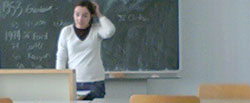
Popular Topics
Choose
Popular Links
| ElectoralSystemUS |
| History | Back to Page
Revision as of 2005-03-08 13:50 FrontPage > BwzNotes > BusinessEnglish2 > ElectoralSystemUS
Electoral System in USSophie painted us the big picture of the US electoral system. Basically, you have three branches.
The idea behind these three instances is, that there's the concept of check and balances. So, say, if the executive for some reason goes havock and wants to do things that Legislative and Judical don't want, he can't do them. The Legislative BranchThe Congress represents the Legislative. What the congress does or does not depends on the Bill of Rights and the so called 10 amendments. You can find the Congress in Capitol Hill, Washington DC. The big joker of the Congress: it can override the veto of the Executive (the president). What does the Congress do? It has a couple of duties like
In fact, the vietnam apparently seems to have happend because of a decision of the congress. More about that later. The Congress consists of two parts The House of RepresentativesIt has 439 members, which depends on population. Every ten years, the population is recounted and the number of members adapted. The leading character in the House of Representatives is called The Speaker. The SenateConsists of 100 members. Every one of them must have been US citizen at least for 9 years as well as at least 30 years old. The Vice President of the United State is automatically President of the Senate. There's also a Prolempore President, which represents him in case of absence. The real power though is in the hands of the Majority Floor Reader. The Executive BranchConsists mainly of the president and the vice president, which are elected for four years. A president must be born in US, so that's bad cards for Mr. Schwarzenegger. Other members of the executive branch include the cabinet, the presidential office, the CIA, Nato and so on. While nations like France have a couple of candidates (in 2002, there were 16 of them), Americans only allow one member of each party to be voted for. The american presidential election is a somewhat tendious process that has three parts
It's "Win or Take All". In 1996, Bill Clinton had 361 presidential electors on his side. He won, even though he only had 49 percent of the popular votes. Some see that as problematic, it doesn't look very democratic to me. But what do I know.
No, I will not look up the oath in the Internet. Power of the presidentThe President has
Supreme CourtThe decisions of the court are final. It is the highest court and the last resourt. Before going to the Supreme Court, the cases have to be heard by lower courts. There is a two party system. If you look closely on the picture on top of this text, you might be able to see them. The Democratic party, which is the older one, has been founded in 1829. Their symbol is the donkey. The Republicans on the other hand have been founded in 1854 and have an elephant as their symbol.
It's quiz time!So, in case you want to travell back in time and boast with you knowledge: I've noted the answers below. Who was president when?
|

 Wiki Toolbox
Wiki Toolbox



